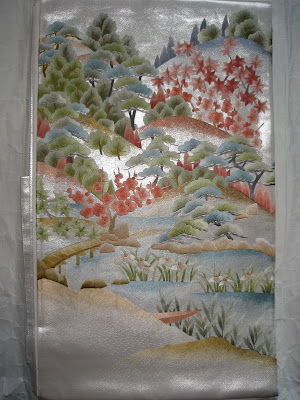























I was asked, by a facebook kimono fan, to write about obi. It is a perfect chance to photograph and post some of my favourites, but also write a bit about obi too. Originally just a narrow hidden tie, that held the kimono in place, the obi has become as important as the kimono itself. It would be unthinkable to go out without some sort of obi on. The obi should match the kimono in value. To pair up an expensive kimono with a cheap obi, is to carry a Louis Vuitton bag and a 100 yen plastic umbrella together. Even in the last 100 years though, obi have been changing and are continuing to change. Before the taisho period, (1920s) they were generally much softer and a reversible one, called a kujira obi was popular. It was usually black or grey and then bright on the other side, (like the under and upper sides of a whale, hence the name.) Then a chuya obi became popular. There are a few in my photographs. They are soft and reversible, not good for tying otaiko, but for big floppy eared ribbons, they are very nice. Another obi which has gone out of regular use is the maruobi. There are two photographed here. They were woven on a loom double the width of an obi, and then it was folded in half. They are hugely heavy and thick, and usually shorter than today's fukuro obi, so are not very versatile for tying fancy knots.
Today, there are three types in regular use. For full formal wear a fukuro obi is required. Usually it is woven in nishijin ori, which has silver and gold threads in it. It can also be tsuzure, finger-nail tapestry weaving, or possibly be dyed by a yuzen artist. Embroidered ones are also popular. The fukuro obi is 4 metres and 10cm long. Unlike a maru obi, it is not an extra wide weaving folded in half, but is usually backed with some plain cloth. It also often has a facing put inside to increase the stability, but you may choose not to have this, if you are tying fancy bows. Some have a repeating design down all but the center section, and some have a design in only one point. The one point ones are for tying nijuudaiko, the double drum bow, required for married women on formal occasions. If you have a design on most of the obi, then you can tie nijuudaiko or fancy bows.
Far less restricting, and easier to tie is the nagoya obi, which is the regular obi for everyday use. According to the fabric it is more or less formal, but basically it is shorter and often sewn in half down about half of its length. It is usually about 3.5 to 4 meters long. The older ones tend to be shorter and are therefore a little difficult to get a good big taiko out of. Some nagoya have designs down the length, and others are one point designs. If you have a one point design, you must be sure that it shows in the correct place, when you make a taiko. You can also make ogidaiko, tsuno dashi or ginza musubi, (non of which I am very good at), and I have also tied one into a big ribbon at the front, and then swizzled it round to the back. Yes, its possible!
The third kind of obi, is the han haba, or kofukuro obi. It is basically a half width obi, and is about 3m 60cm long, though there are longer ones for parties, and shorter wool ones for summer yukata. They can be tied in numerous ways, the most common ones being bunko and kai no kuchi.
Choosing your obi can be difficult. They say to have three obi for each kimono. As a very rough guideline, a woven obi with silver and gold in it, can not be worn with a woven kimono, only with a more formal dyed kimono, (including komon, iro muji, homongi and tomesode.) A kimono which is woven, wool, tsumugi etc, must be worn with an obi that is woven with plain threads or a dyed obi. You can up and down the formality with accessories too. If you look at the half width obi photograph you can see that they are all different types and many are cut down from other obi. If they are gorgeous weaving, they can be used for a party on dyed kimono. Adding an obi jime and obi age will increase the formality. Some designs also belong to certain seasons, too. Here are grapes, (end of summer) maples (autumn) cranes (new year and celebrations) etc. Also it is important how you pair the kimono and obi together. Exactly the same design is considered boring and unoriginal. A related design, is cool. If not by design then colour, a lighter or darker shade, a contrasting shade or picking up one colour from the kimono usually works well. If you are not sure, then go for the safe option. I still ask a lot of advice from older kimono wearers.



